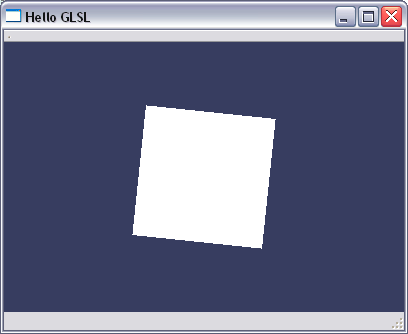In this tutorial we will extend the previous tutorial and make use of a Shader written in GLSL to fill our spinning quad. GLSL is a C-like language you can use to execute code on your GPU (aka graphics card). More sophisticated effects can be achieved with this technique.
The point of this tutorial is to show how Qt supports shader programs and how to use them in your application.
Sourcecode: Hello_GLSL.zip

Using GLSL Shaders with Qt
Qt already provides two classes to work with shaders. We just have to add some function to use them.
The first class we need is QGLShaderProgram. It provides a container for our shaders and comes with functions to link and use the shader programs while rendering OpenGL objects. The second class is QGLShader. This class supports loading and compiling various (vertex, geometric, fragment) shaders written win GLSL. To use these classes include
We extend the RenderThread with a function to load a vertex and fragment shaders given in two separate files. The filenames are passed as two QString parameters.
void QGLRenderThread::LoadShader(QString vshader, QString fshader)
{
if(ShaderProgram)
{
ShaderProgram->release();
ShaderProgram->removeAllShaders();
}
else ShaderProgram = new QGLShaderProgram;
if(VertexShader)
{
delete VertexShader;
VertexShader = NULL;
}
if(FragmentShader)
{
delete FragmentShader;
FragmentShader = NULL;
}
// load and compile vertex shader
QFileInfo vsh(vshader);
if(vsh.exists())
{
VertexShader = new QGLShader(QGLShader::Vertex);
if(VertexShader->compileSourceFile(vshader))
ShaderProgram->addShader(VertexShader);
else qWarning() << "Vertex Shader Error" << VertexShader->log();
}
else qWarning() << "Vertex Shader source file " << vshader << " not found.";
// load and compile fragment shader
QFileInfo fsh(fshader);
if(fsh.exists())
{
FragmentShader = new QGLShader(QGLShader::Fragment);
if(FragmentShader->compileSourceFile(fshader))
ShaderProgram->addShader(FragmentShader);
else qWarning() << "Fragment Shader Error" << FragmentShader->log();
}
else qWarning() << "Fragment Shader source file " << fshader << " not found.";
if(!ShaderProgram->link())
{
qWarning() << "Shader Program Linker Error" << ShaderProgram->log();
}
else ShaderProgram->bind();
}
After some cleanup in case there was already a shader program active, we load first the vertex, then the fragment shader program and compile them. When we are successful the shaders are linked to our ShaderProgram and thats it.
One good thing when using the Qt functions is that you get the error messages from the GLSL compiler for shader debugging purposes (Shader->log()).
After that we can load our basic shaders
void QGLRenderThread::run()
{
GLFrame->makeCurrent();
GLInit();
LoadShader("./Basic.vsh", "./Basic.fsh");
//...snip...
The sample shader programs are pretty easy (=dull). I won’t go into details here.
Vertex Shader:
void main(void)
{
gl_Position = ftransform();
}
Fragment Shader:
void main(void)
{
gl_FragColor = vec4(1.);
}
Conclusion
We have shown how to include GLSL-Shaders with Qt and render a simple white quad. More to follow.